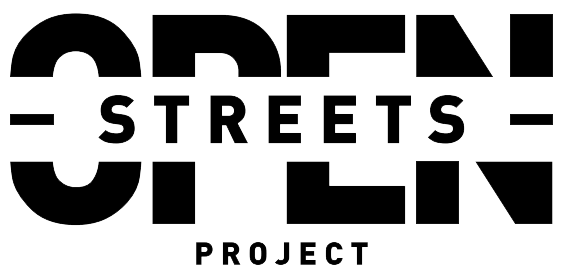Nuts and Bolts
The information here is meant to serve as a guideline for Operational and Logistics issues surrounding your program. Volunteers, securing the route, purchases and delivering services like signage and volunteers kits, it is all here. Keep in mind that every city is different, so this is meant to be more of a guide than hard and fast rules.

Volunteer Roles and Responsibilities
Volunteers are the backbone of any Open Streets program. But where do you start? Where can you find volunteers? What tasks should each volunteer do? This tool will help you answer that question!
Using the descriptions below and the accompanying graphic, you can easily calculate the minimum number of volunteers you will need at your Open Streets program. We suggest creating a master volunteer map of where each volunteer should be.
Be sure to check with the body issuing your permits to confirm where you can use volunteers and where police or traffic officers are necessary.

Block Captains
Position Description:
- On a bicycle, oversee all volunteers within a segment of the open streets route (the length of that segment will be dependent on the length of your route – typically 1-2 miles/2-3km)
- Ensure there are enough volunteers for that segment and that they are fulfilling their responsibilities
- Each Block Captain should have a volunteer map of the route segment they are responsible for.
- Be prepared to address any issues that might arise within their segment of the route
Block Captains need to be very responsible and trusted volunteers. Ideally the volunteers in this position would be trusted community leaders who are pre-selected.
Roving Cyclists
Position Description:
- Circulate through a portion (1-2 miles/2-3km) of route for duration of an Open Streets day
- Encourage people to move into the roadway and off of the sidewalks when the program begins
- Routinely check on Ambassadors and Intersection Monitors and offer biology breaks.
- As the end of the program nears (in 30, 20, 15, 10, 5 minutes), advise participants and volunteers, and ensure once it is officialy over that participants move back onto to the sidewalks.
- Under the direction of a Block Captain, circulate through the portion of the route under their direction.
- Ensure this portion of the route is constantly staffed with the appropriate number of volunteers for the route.
It is important that Roving Cyclists be familiar with the various responsibilities of the volunteers they offer breaks to.
Barricade Attendants
Position Description:
- Responsible for looking after a hard closed street, typically hard closed with a barricade
- Prevent unauthorized vehicles from entering the route
- Assist with entrance/exit of authorized vehicles (if permitted)
- Greet participants as they enter/exit Open Streets
- Answer questions as necessary
Encourage Ambassadors to make the barricade “their own” with music, signs, decorations, costumes, etc.
Intersection Monitors
Position Description:
- Stop participants on the Open Streets route, with signage or bright colored rope, when they come to a red light at a car crossing point.
- Keep participants from entering the intersection while cars move through the intersection on their green light.
- When the participants have a green light, move the sign or rope and allow participants to move through the intersection.
Watch this animation for a visual on how this would work
This position requires concentration on the light cycle, therefore Intersection Monitor volunteers should be given regular breaks.
Evaluators
Position Description:
- Collect information from Open Streets participants by conducting surveys
- Count participants at the top of each hour
- Conduct post-Sunday surveys with stakeholders along the route
- Gather testimonials from all different types of participants
See our evaluation tool for ways to evaluate your Open Streets program.
Set-up & Take Down
Position Description:
- Assist with set-up or take-down of barricades, signage, tents, activity hubs, cones, clean up, and other operational logistics before and after the event.
The quantity of these volunteers depends on the length of your route, the required equipment to close your street, the process of setting up and taking down the program, and how complex your complementary activity hubs are logistically.
Other Route Specific Volunteers
Your route might require extra support in specific areas i.e. asking people to slow down on a hill, or asking cyclists to dismount in a pedestrian area, coordinating complementary activities, etc. These positions will be specific to your program.

Volunteer Training
Ideally, it’s great to meet your volunteers before the first date of your Open Streets program. That way you have a better understanding of what positions individuals will be best suited for. Consider hosting a couple of volunteer training options where you can brief individuals about the program and they have the opportunity to ask questions about their positions.
We suggest creating a core curriculum that all volunteers will receive that includes the following information:
- What is Open Streets? (1-2 sentences they can use to describe the program to people who ask)
- What is (insert name of your Open Streets) all about? (I.e. Open Streets Thunder Bay is a program that will open Algoma Street from John street to Boulevard Lake to people on July 12th and September 14th to walk, run and play…)
- What the route is and where the activity hubs are
- What intersections are open for traffic, where transit routes have detoured, and other important travel information that might be relevant to participants
- Emergency situation protocol
- Necessary character and demeanor when dealing with participants
- Mandatory arrival time, appropriate clothing and footwear, what resources they will be receiving (i.e. t-shirt, snack?)
- Where restroom facilities will be, protocol for breaks, etc.
After each volunteer receives the above information they should be briefed on the specifics of their volunteer role and responsibility. Use the information above to guide the education of volunteers in each role.
Give some thought to what you want volunteers to leave their training with. These things could be:
- Information sheet about your open streets program
- Instructions for the day they will be volunteering (arrival time, duties of their position, where to check in and get their necessary tools, etc.)
- Contact info for who they should contact if they have questions, cannot make it, etc.
- Swag to share with friends
- Encouragement to connect with your Open Streets program’s social media platforms to heighten the conversation about the program

Volunteer Recruiting
Once you know how many volunteers you will need for your program you’ll have to find that number of people to fill the positions! Where might you find them? Think about the kind of people you want to volunteer, what groups are already advocates of your Open Streets program, and who might have people willing to volunteer at your program or would be willing to spread the word about it?
These groups might include:
- Your open streets webpage/facebook page/twitter and instagram followers
- Recreation economy: Cycling/Running/Walking/Yoga/Boot camp groups
- Service clubs
- Corporations
- High schools, colleges, universities, and other educational institutions
- Job Boards
- Local Businesses
- Volunteer centres
- Active transportation advocates
- Local leaders and their networks
The easiest method to register individuals as volunteers is to have them fill out an online form with their information. This will help facilitate communication and management.
At a bare minimum you should ask for the following information from prospective volunteers:
- Name
- Are they under or over 18
- Preferred volunteer position
- Phone number
- Availability
- Postal code
Other questions that could be helpful include:
- Do they own and bicycle and feel comfortable riding it during open streets and with traffic?
- Why are they interested in Open Streets?
- Are they using Open Streets to fulfill community service hours?
Be sure that you have a system in place to respond when prospective volunteers fill out your online form. Likely, this will be an automatic reply email expressing your thanks for volunteering and that someone will be in touch soon or lists the dates for volunteer training sessions.
Sometimes it’s challenging to find enough volunteers to staff your Open Streets program but anything is possible! Check out these innovative ideas to fill volunteer positions. Do you have an innovative way to recruit volunteers? Share it with us!

Timeline
Below is a ‘best-case scenario’ timeline. Keep in mind you may have much more time, or much less time, than described below due to a number of variables: You may not have your route solidified until a couple of months before; you may be holding your breath for funding until a few weeks before; or, you may not officially receive your street closure permit until just days before. In these cases, it’s normal to worry, but do not panic! The MOST important things are:
- You need a safe and secure route
- And you need people on it (For more information on this check out our marketing tool!

In Advance
6 months before the first program date
- Finalize route plan
- Start traffic management plan.
- Contact your local municipally and authorities (police, EMS, fire) to determine necessary permits and plans required for your program.
- Submit Permits (This may include special event permits, road closure permit, park permits etc.)
- Develop volunteer plan—they play a key role in your traffic management strategy.
3 months before
- Launch call for volunteers
- Source program materials which may include:
- Volunteer uniforms, T-Shirts, etc.
- Signage and banners (*Tip: when possible, keep your signs and banners generic (ie. No dates) so that they can be re-used for future program dates. Also limit numbers of signage and banners to simplify set-up and take-down.)
- Barricade tape, zip ties, zip tie cutters
- Radios/walkie-talkies (rent or purchase)
- Storage Tubs and/or large bags for delivery of materials during program dates
- Volunteer materials (water, snacks)
- A company to conduct the road closure or source barricades, road closure signs, and people to set up the road closure on the day of the program. (*Tip: some programs have purchased their own barricades, which is a large upfront cost but will lower the costs of the program over time. They are then renting them to other street closure events to generate funds for the open streets program.)
- Source, if necessary (these will increase the expense of the program, so you may want to think creatively about how to lower the costs of each item):
- Towing companies (for vehicles parked on the route)
- A tent (or trailer), table, and chairs to centralize your team on the program day (rentals or purchase)
- Private EMS service/security service if necessary.
- Portable toilets (can you find businesses along the route that would be willing to advertise their washrooms to participants?)
- Water re-fill station (can you find businesses along the route that would be willing to advertise that participants could fill a water bottle there?)
1 month before
- Order/purchase all necessary materials and signage
- Select volunteers and assign them tasks
- Develop signage and material drop-off strategy. (We recommend identifying pick-up/drop off locations along the route that correspond with your route sections identified in your volunteer plan.)
- Identify drivers for signage and material drop-off.
- Identify Operational Support staff (people who will support operations and troubleshooting day-of. We recommend dividing the route in segments which each person will oversee)
- Develop draft day-of Operations plan in collaboration with Operation Support staff.
- Optional but recommended: Develop a plan for Volunteer Appreciation (i.e. After Party)
Week before
- Volunteer training
- Inventory and organize purchased materials: Organize your materials by drop-off locations/route segments. Mark everything clearly.
- Check-in with volunteers, drivers, police, EMS, municipality
- Review day-of operations plan with Operations Support
- Identify parking location for delivery vehicles
- Confirm meeting locations for your team
- Send out written instructions and important contact information to relevant parties (i.e. Drivers, Volunteers, Support staff etc.)
- If possible/necessary, put up signage for advanced warning of road-closure
Day before
- Review day-of plan with your team
- Charge walkie talkies. Tune to correct station and test transmission with team members.
- Check that everyone has written instructions and important contact information.
- Pack volunteer kits (you’ll have to do this the day before if your kit includes a healthy snack such as fresh fruit/food, which we recommend to keep everyone energized and happy!)
- Double-check signage and materials
- Load truck/van
- Bag parking meters and put up no parking signs (or hire someone)
- Drop-off barricades and road closure signage (or hire someone)

Day of Open Streets
7:00am Meet Your Team
- Meet your team and support people at a central location
- Check that all your radios/walkie-talkies work
- Review material and signage drop-off strategy with driver(s)
- Begin material and signage drop-off
- Check-in with Block Captains and Roving Cyclists. Review duties.
- Check-in with road-closure team/company for status update.
8:00am Volunteers Check-in
- Conduct volunteer check-in (this may be done by each block captain for the area they are responsible for) and review position duties
- Volunteers practice duties
- Check all ‘soft-closed’ intersections for appropriate management
- Survey route to ensure it is secure and free of traffic
9:00am Start Time!
- Continuously survey route for trouble-spots
- Check-in with Operation Support Staff and Block Captains at least once an hour to offer support, guidance.
- Take a deep breath and try to find a moment to soak in the moment.
1:30pm Closure Preparations
- Begin closure preparations (cut down zip-tied barricades, begin collecting materials and placing at drop-off/pick-up locations.)
- Begin announcement of impending Open Streets ending
- Check-in with road-closure team/company in preparation for program end.
2:00pm Road Re-opens
- Road-closure team/company begins to remove barricades
- Road re-opens to vehicles
- Volunteers begin to remove all signage
- Volunteers put materials back in kits and place at pick-up/drop-off location
- Drivers pick up materials and signage along the route
- Survey entire route to ensure it is accessible to traffic and all barricades have been picked up.
- Survey entire route to ensure signage and materials have been picked up.
3:00pm
PARTY!!
6:00pm
SLEEP!!

Week After
- Inventory all materials and signage
- De-brief with you team, hired companies, EMS, Police, municipal staff and volunteers
- Document issues and areas for improvement for your next program date.
- Review data gathered from evaluation efforts and create report that can be used to bolster efforts for future program growth



